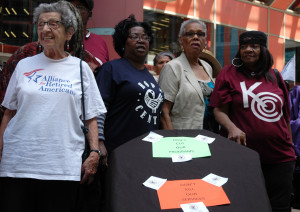Major Questions for Senior Care in IL as Controversial Task Force Meets Today; Cuts or Care? 2nd-Class Services on the Way? Is CCP Safe?
 As a controversial task force that appears to have been rigged by the Rauner administration meets today jointly in Springfield and Chicago at 1 p.m., major questions have arisen for the future of home healthcare for seniors in Illinois.
As a controversial task force that appears to have been rigged by the Rauner administration meets today jointly in Springfield and Chicago at 1 p.m., major questions have arisen for the future of home healthcare for seniors in Illinois.
The Illinois Department on Aging (IDOA) task force already is under fire for excluding major stakeholders in the Community Care Program (CCP), which saves taxpayers hundreds of millions of dollars as it provides services for as many as 100,000 Illinois seniors. Now, as the task force concludes its work, it appears to be incubating some ideas passed down from the failed attempt this summer by Gov. Rauner to cut $120 million from the program, reducing care by a third for almost 40,000 seniors.
PILOT PROGRAMS
The Rauner administration is diverting IDOA funds to two pilot programs in Bloomington and East Moline featuring “flexible” services along the lines of its ill-conceived “Community Reinvestment Program” that was thwarted by the General Assembly this summer as part of the bipartisan budget compromise passed over Gov. Rauner’s veto.
At least one of the pilots is reported to be having difficulty with its funding mechanism, just as it was supposed to begin.
- What is the status of each pilot program and what are their budgets?
- From where in the IDOA budget have funds for the pilots been diverted?
- How are seniors being recruited and/or chosen to participate in the pilot programs?
“FLEXIBILITY”
Some of the recommendations to the task force stress “flexibility” and “flexible services” for some seniors in the Community Care Program, but that “flexibility” appears to be masquerading as a means to cut services and keep wages low.
- Does “flexibility” stand as a euphemism for cutting costs, keeping wages low and reducing services?
- Does this task force see its primary mission as a place to cut costs or as a place to improve services for senior consumers of the Community Care Program?
- What guarantees are there for seniors that “flexibility” doesn’t translate to their preferred caregivers being laid off and their service levels, including service quality, being reduced?
SECOND-CLASS CARE
Recommendations under consideration by the task force include tiering benefits for seniors in the Community Care Program who are NOT currently covered by Medicaid, even though this population (almost 40,000 consumers out of as many as 100,000) generally cycle in-and-out of Medicaid eligibility frequently.
- Are non-Medicaid seniors going to be provided lower-class care under this program?
- Will this task force consider reducing the maximum value of services for non-Medicaid seniors?
Today is the last scheduled meeting of the task force, at which members are supposed to finalize recommendations so IDOA staff can create the report that will be sent to the General Assembly in January.
Is senior care safe?
